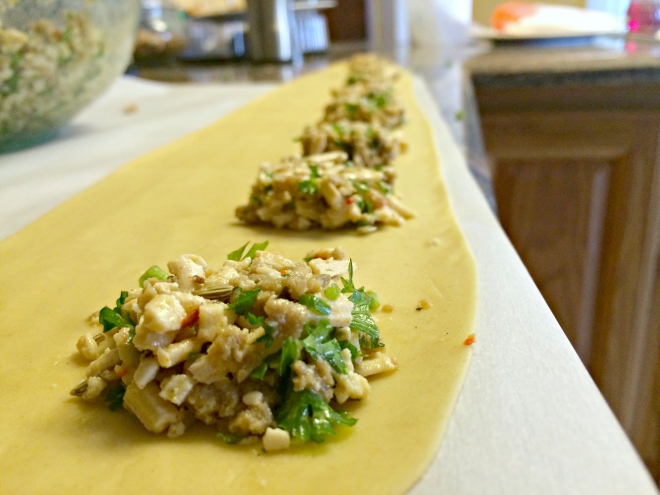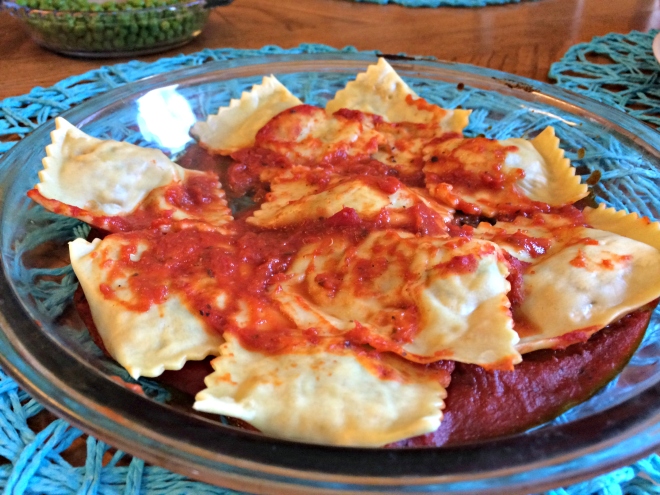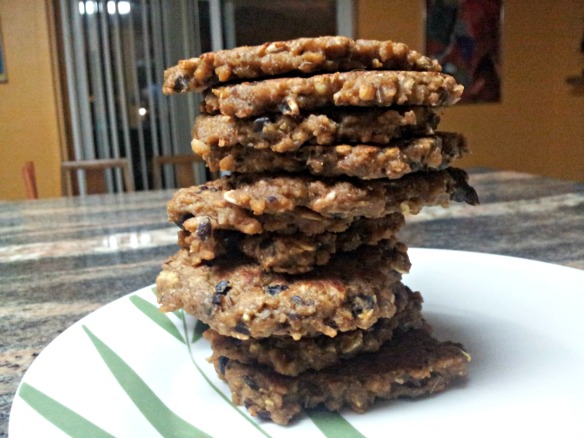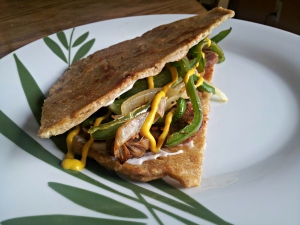Another fantastic take on tacos, though this one more evidently: Chorizo, potato and onion, lonely bean’d with an egg. A fine, swarthy feast from How sweet eats.
Tag: Sausage
Spinach and sausage ravioli
Likely, the original impetus for this recipe would be horrified by what has been done to it, the result, though, was regardless — delicious.
Verily, all the cheeses were eschewed, not being on hand. However, a Daiya pepperjack was used — completely alienating the result from it’s creamy, ricotta and cream cheese inspiration.
Only a passing glance was had as the boy consumed them near entirely…
Waterloo pie: Spinach pesto, caramalized butternut & Italian sausage
The most direct route to school was via Vernor Avenue. St. Aubin to Vernor to Burns. Eight years of travel brought familiar landmarks that were often commented of… The plant house – a plant in nearly every window, ferns hanging on the porch, the yard neatly manicured and filled with flowers, meticulously maintained through the years, and even now, standing if worn and wont of plants in a zone increasingly called prairie. The big green house with the massive stove pipe that made a sharp right-turn toward the sky, capped just above the roof – the home of a later acquaintance in high school, coincidentally. The cat house – that crawled with cats for decades, now, no longer standing. Adjacent was a home where, for a time, multiple dogs resided – became the dog house, but was short lived. The churches… The beautiful homes of Indian Village…
There ain’t a whole lotta houses left down on our end of that neighborhood – south of Vernor has seen an increase in the multi-unit town-homes and condos, crossing Bellevue still seems like a neighborhood – not even Hantz is plopping in his trees down there. It’s such a great location it seems odd there’s so much abandonment; likely development will spring up sooner than later.
For whatever reason, there were times we skipped Vernor – maybe to avoid the back-up of Gratiot traffic, or maybe novelty. Instead, we’d cut off at Antietam, and take that around to Chene – in fact, that became a very common route. I have a very specific memory of approaching the light at Chene and vernor – Dad was fretting about the brakes, how hard it was to stop the old white, ’73 Malibu with the light blue, vinyl interior.
It ended up only driving in reverse, at the end of its life and once caught on fire. No harm – the guys at Towers raced out with extinguishers as dad pulled his Chevy flambé onto their lot!
He wanted to gun the car through the light, to avoid having to stop – but the car ahead of us braked hard. Dad decided to use the emergency brake. Of course, the wheels locked up, and the car slid – tires screeching, back-end fish tailed! The guy in front of us looked terrified, but we stopped. Dad didn’t try that again, rather opted to start braking cautiously and well in advance – not a natural behavior for him. He drives a G35 coupe, now, and our neighbor once commented, he often saw dad whiz past him on the freeway!
Way back before the Elmwood area began to expand beyond the grand razing of the 1950’s and ‘60’s, those trips to school across Antietam and up Chene, led to the discovery of a little tiny road, just shortly before intersecting Vernor. It was poorly maintained and barely visible at times, part brick, part patch and dirt. It scooted from Chene to McDougal, then, along the cemetery where it was maintained a little better. The homes wrapped by Prince Hall Dr. eliminated one block and the expansion of Elmwood cemetery the better portion. A small spit still survives by the old Miller school and two formal blocks of little Waterloo still remain between Mt. Elliot and Beaufait – where recollection fails if it always concluded, but somewhere thereabout, merging back into Vernor.
There were rarely any other cars on the road, and that little back-track added an exciting, magical twist on our mornings, washing out the waves of nausea and pit in the stomach, often accompanied by rousing choruses of “It’s not easy being green,” or, “Oh what a beautiful morning.” It may have actually extended all the way to St. Aubin, at one time, but by the time we got back from New York, in ’78, that stretch at least was gone – a multi story planted there – and much of the road had become impassable. If you walk behind the town-homes on Vernor, right in front of the cemetery, you can still find pieces of the road, however, they’re disappearing with time and vegetation.
Like the road was often, and parts have become, the Waterloo pie is green – spread with a delicious spinach pesto, topped with caramelized butternut squash, roasted garlic and Italian sausage, cobbled together with a sprinkle of cheese.
Waterloo pie is an outstanding, rich and delicious pizza – Jen turned Guy Fieri after a couple bites, “It’s got the sweetness of the butternut squash, followed by the saltiness from the sausage, and it all comes together with the subtle flavors from the pesto!”
Back in the early 1900s entrepreneurs peddled their wares from carts on neighborhood roads, street cars provided reliable mass transit for the growing region and horse racing was king. That’s right — horse racing was big in Detroit once upon a time.
Many streets in Indian Village have Indian names, yet according to Nick Sinacori, quoted in an article in ModelD, at modeldmedia.com by Rodd Monts, two streets Iroquois and Seminole were named for topperforming race horses and Waterloo was named not after the battle, but for a horse farm of the same name in the area. In fact, Iroquois reportedly won 145 races and earned nearly $200,000 – a huge sum in those days.
Sinacori lives in the same home that his grandfather bought not long before he went off to help fight World War I, on Newport Street, near Jefferson and Chalmers. The area used to be known as the Village of Fairview. Sinacori is a living history book on the area.
When he was a teen, one of Sinacori’s uncles told him a story about how he used to sell fruit from a horsedrawn wagon, and on weekends would race the horse in pickup races to earn extra money. He found the story interesting but didn’t fully understand how prominent horse racing was back in the day until his grandfather planted another seed. Sinacori recalls inquiring about why two blocks of Marlborough Street at Jefferson are the only blocks in the area paved with bricks.
“He said ‘That’s where they ran the horses.’ I said ‘I don’t understand, you mean they ran them up and down the street?’ But he said ‘you’ll find out in time.'” As it turns out, the brick lane on Marlborough was once a path that led to the Detroit Jockey Club. Sinacori found that was the second track in the area. He later discovered there was a third large track on Jefferson, the Hamtramck Track, which was further west in the neighborhood now known as Indian Village.
The Detroit Driving Club may be the most important of the three. The entrance to the track was where, today, Algonquin Street meets Jefferson, and if you drive by you can picture where the gates once sat and trees lined the entryway (Algonquin is said to be a boulevard for precisely that reason.)
The problem was that neither Detroit nor Grosse Pointe wanted to pay for the road to be paved, Sinacori says.
Eventually the Village of Fairview sued Grosse Pointe to cover the cost and won, reportedly $186,000 at the time, and the road was paved — from Beniteau to Cadiuex, and it was the second paved road in the region (after Woodward Ave).
“Here we have urban politics. We have transit politics. We have horse racing issues; the early, beginning stages of the automobile industry,” he says. And one might say the beginning of Detroit as we know it.
Whatever happened to Fairview you may ask? Well that’s a story for another time.
This article was originally written by Rodd Monts, a Detroit-based writer who often contributes to Model D. It was edited for Detroit History by freelance writer Craig Sasser.
Perfecting the patty
Frequent formulation of the little breakfast patties has been a function of facility and form, as much as fervent appeal, or preference over the alternate links — the two types determinately settled, sans pariel. Pretty good; reasonably satisfactory…
Slowly, still, slight transmutations have addressed the small snipes, adding texture and chewiness; increasing moisture. The current, minimal manipulations — modifying the modifications of the now extinct originator, obligating the offerings of another — might manage a more marveled measure.
Either way, either one, every time, is like the first time, and never precisely or perfectly replicated. Such, so, with solid success staring squarely from the skillet, stands – somehow – something esteemed as super, as so:
Ingredients
■½ cup textured vegetable protein
■1 Tablespoon wheatberries
■½ cup boiling water
■¼ cup whole wheat flour
■1 Tablespoon wheat gluten (or a little more…)
■2T flax seed meal
■¼ cup ground oatmeal
■2 tablespoons nutritional yeast
■1 teaspoon garlic powder
■½ teaspoon crushed sage
■½ teaspoon rough ground caraway
■¼ teaspoon black pepper
■1⁄4 teaspoon chipotle powder
■¼ cup water
■1/4 cup mashed black beans
■½ teaspoon liquid smoke
■3 tablespoons Braggs
■1 teaspoon maple syrup
■¼ teaspoon blackstrap molasses
■oil ( for frying)
Directions
1.Stir together tvp, wheatberries and boiling water.
2.Mix dry ingredients.
3.Mix wet ingredients.\
4.Stir in tvp. Stir in liquid. Make patties
5.Fry in lightly oiled pan until browned. Obviously flipping, at some point, so that both sides are. Browned.
~Freeze great, too. re-heat for 30 seconds in a micro.
This was originally stolen from someone who has killed their blog, that thieved it from Helly eah its vegan, who absconded with what was found at Vegetarians in paradise — perhaps the origination? That site, is run by Aunt Nettie, who is certainly not the same one that kidnapped a child, or, was at least complicit. It’s like an internet game of telephone, whispering ingredients, resulting in Compositional Nominal Variants, or Sausage Novel Propositions. In this case, however, the story remains significantly intact, with only a few mis-applied pronouns.
Soyaki sausage
Links… impelled to eventuality by the calling of a pleasantly shaped flask, corked – the top third – with sesame seeds; curiously labeled, stoking intrigue, during an aimless aisle amble at the Trader Joes.
A teriyaki generally substitutes for soy in the sauce: With this dandy, brandy-styled bottle, it demanded to stand the sole actor, making the bitty bangers a bit sweeter – a nice variation to the veritable, vogue version, a wonderful, wee whimsy.
The catch with these is to cook them just long enough that they hold together: Forty five minutes – excluding the time taken, turning – gets them close, with perhaps another carefully monitored five, depending on the altitude, humidity and position of the Galilean moons. Finished is to the point, the liquid is absorbed but a slight glaze of moisture still coats the pan.
Sandwich
the Oak Packing spicy pita
An appropriate Saturday lunch
Just as messy as the original, with italian sausage, spicy sausage, onions, pepper and yellow mustard.
There was even cider — rare this year — to accompany.
Served on a thin version of Tibetan flatbread.
**Ack!! Forgot the pickle**
Siracha and five spice sausage
A nicely spicy sausage ala Olives for Dinner:
Far too much caution was taken with the spice level for these four large links, however, that was easily recompensed by slowly sautéing the slices in a little chili oil.
Nice hearty, warming breakfast in our house with no heat, astutely accompanied with peppered potatoes.
These will make a nice pita pocket sandwich in combination with the Italian – just like the spicy pita with onions, peppers, mustard and a dill pickle from Oak Packing where they always call dad, “Bob.”
Hey Bob.
Sausage patties, the first
The recipe as the site is now, apparently, defunct:
Sausage links
Credited to Bryanna Clark Grogan and via Veganwolf, these are really close to what I’ve been looking for, for a link.
They have a good texture and great spice; they are just a bit soft and the salt could come down at least 25% — there’s salt, broth and soy sauce in the recipe and more soy in the cooking broth.
Still these are really good and the first link recipe that wasn’t a complete disaster or seitan — which don’t seem to brown up well.











